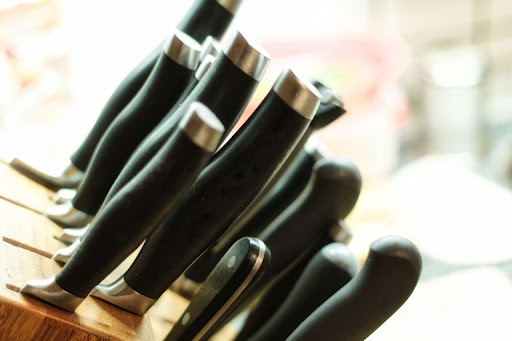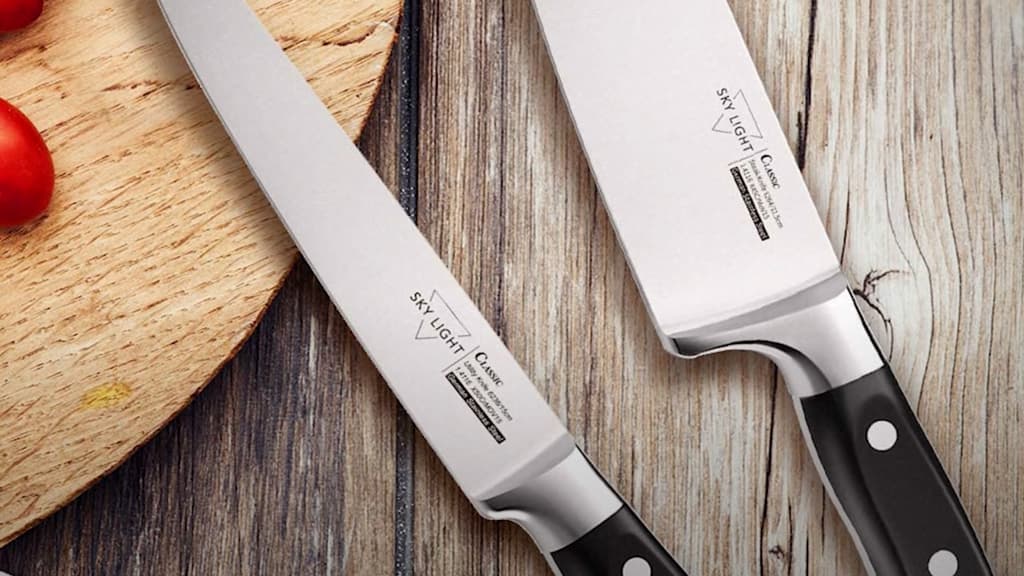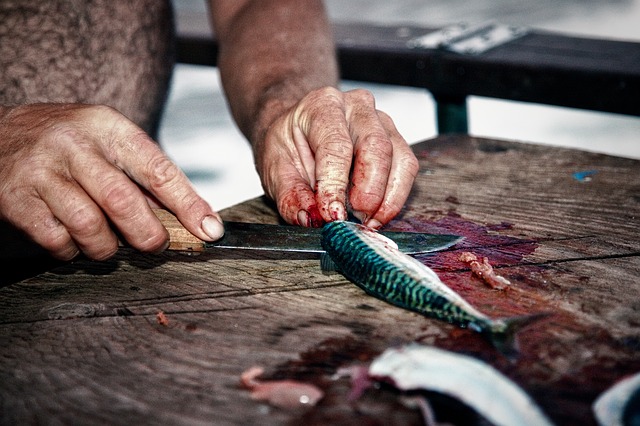While searching for a top-quality kitchen knife, you will come across both Japanese and German styles. These are two of the most popular varieties worldwide, thanks to their brilliant designs and craftsmanship. Japan and Germany’s old traditions of metal forging and weapon manufacture have contributed to the success of their modern kitchen knives.
The perfect style for you depends on your cooking and preferred cuisine. Japanese knives are sharper, slim, and flat, so are effective at thinly slicing fish and vegetables. German knives tend to be bulkier and rounder, and therefore cut thicker pieces of meat and tough vegetables effectively.
Today, people are trying more diverse dishes from different cultures than ever before. This has led to people needing more versatile knives. Japanese and German manufacturers have started to create hybrid-style knives that retain the best features from both designs and are suitable for most cuisines and ingredients.
However, choosing the right knife is not a straightforward decision. Though a well-made Japanese or German knife is not a cheap utensil, it is indispensable and crucial to every step of meal preparation. Now we will break down the features of both knives to give you a better idea of each type’s strengths.
Table of contents
Why are Japanese knives different from German knives?

Japanese and German knife designs evolved based on the dishes they had to prepare. The parameters of each knife are designed to fit the ingredients chefs chose to chop upon. German cooking focuses on tough meats (pork, beef, sausages, steaks), as well as bread, cheese, and potatoes. Cutting through these items requires a sturdy and heavy knife.
Japanese cuisine is famous for its sushi, noodles, rice, and soup. A lot of delicate work goes into presenting dishes and making them look beautiful. Making precise slices needs a slender and razor-sharp knife that will stay sharp for long periods.
German and Japanese cuisines could not be more different, so it is no surprise that their knives differ greatly. The differences go beyond the shape and weight of the blade. The handle material, bevel, bolster, and price are all important factors to consider when choosing between a Japanese and German kitchen knife.
Although we will be comparing the standard Japanese and German chef knives, both countries offer more specific tools. For instance, boning, bread, or fish knives.
Japanese vs German kitchen knives
| Japanese knives | German knives | |
| Steel | Traditionally high-carbon steel. Stainless steel is also used nowadays. | Stainless steel. Some alloys contain chromium. |
| Bevel | Original Japanese knives had single-bevel edges. New models are made with both single bevel and double bevels.The angle of the bevel is between 10° and 17° on each side. | German chef knives always have a double bevel on their edges.The bevel angle is between 17° and 22°. |
| Blade profile | Santoku knives have quite flat edges with a subtle tip.Gyuto knives look similar to Western styles with their curved edges. | A distinct curved blade with a pronounced tip and a mostly flat spine. |
| Handle design | Cylindrical or octagonal without finger contours.These knives have a narrow tang and are therefore heavier in the blade section. | Ergonomic with curves for fingers.German knives often have a full tang, giving them extra weight in the handle. |
| Handle material | Hardwoods like ebony and magnolia. Wooden handles are sometimes stabilized. | Synthetic polymers such as ABS and polypropylene.Wooden handles also exist. |
| Bolster | Traditionally, Japanese knives have no bolster. New models do incorporate this feature. | Almost always. German knives can have a half or full bolster (with a finger guard). |
| Weight | Around 5 ounces (150g) | Close to 10 ounces (300g) |
| Use | Suited to Japanese cuisine i.e. fish, vegetables, and soup.Newer designs are good for preparing global dishes. | Suited to cutting tough ingredients in German cuisine i.e. pork, cheese, bread, and potatoes. |
| Price | Generally quite expensive. The cheaper models sell for $200-300, while top-range knives cost $500 or more. | More affordable. You can find very good-quality German knives for $100-200. |
Knife blade
Steel
Japanese steel blades traditionally have a high carbon content. This increases the hardness as well as the brittleness. High-carbon steel Japanese knives keep their sharp edges for a long time, but the harder steel is tricky to sharpen.
German and, broadly speaking, Western kitchen knives are manufactured with softer stainless steel or its hybrid. This can blunt more easily, but is more durable and protects against rusting better than high-carbon steel. Most German blades contain chromium which makes the knives even tougher.
The above features are by no means fixed. Japanese knives are increasingly made with stainless steel too. You can also find composite blades with hard high-carbon cores and softer steel in the outer layers. Likewise, some German companies sell steel knives with a higher carbon content nowadays.
Bevel
The bevel of course refers to how the knife edge is sharpened. This has a big impact on the technique needed to cut with a knife.
Type
Original Japanese kitchen knives had a single bevel. The benefit of this style is a very sharp blade. You must be more precise when using the asymmetrical single bevel because there is a small margin of error with its small angle.
Single bevel knives are also limited in that right- and left-handed cooks have to use them differently and may prefer the bevel on a different side.
A double bevel blade is sharpened on both sides of its edge, so it cannot be as sharp as the single bevel type. German and other Western knives always have a double bevel edge. Naturally, you have to sharpen two sides of the edge instead of just one. The symmetrical double bevel is equally accessible to right- and left-handed users.
Nowadays, Japanese blades with double bevel edges are common. Alternatively, they can have asymmetrical double bevels where one edge is steeper than the other.
Angle
For this comparison, it is appropriate to focus on Japanese and German knives with double bevels. By angle, we mean the angle between one side of the edge and the vertical centerline of the blade (essentially, this is the angle of half the blade).
German double bevel knives have an angle between 17° and 22° on both sides of the edge. Japanese double-bevel blades can have angles anywhere between 10° and 17°, hence the edge is more pronounced. It is clear that, regardless of the bevel choice, Japanese blades are sharper than their German equivalents.
Blade profile

The German chef knife has a rounded cutting edge that starts to curve upwards near the blade center. Its tip is distinct, while the spine is mainly flat until it curves down towards the end of the blade. The round blade affects its movement because chefs will typically cut in a rocking motion with a German chef knife.
There are two major multipurpose Japanese chef knives. The Santoku’s blade is distinct from the German knife with its much flatter edge and gently curving tip. The spine of the Santoku has a mostly flat profile until the blade’s end, where it bends downwards to join the edge and form the point.
The Gyuto is the other main Japanese chef’s knife. This has a narrower blade than both the German and Santoku styles, yet its shape is more like that of Western knives. Much like a German knife, a Gyuto will roll on a chopping board due to its curved edge.
Knife handle

A knife’s blade is not its only important section. The handle of a knife is your interface with the blade. Your knife skills can be helped or hindered by a comfortable and sturdy handle.
Design
Japanese knife handles have a slim circular or octagonal shape without any contours for fingers. They are not the most comfortable and it takes time to become familiar with the grip. German knife handles are a better fit for your hand, with obvious curves to accommodate your fingers.
The tang is the piece of metal below the knife blade that forms the basis of the handle. The size of the tang influences the weight distribution of the knife. German knives often have scales added to the tang to make them easier to hold. German knives also have a full tang that is as wide as the scales, making them heavier towards the bottom. The tang is the slim metal strip you see in the center of German knife handles ― rivets join scales to the tang.
Japanese knife tangs taper inside the handle. Unlike the German variety, the tang is not visible in a Japanese knife handle because it is surrounded by its scales. The thin tang moves the center of gravity in Japanese chef knives further up the blade to give you more controlled movements.
Material
Wood is the main material used in Japanese chef knife handles. If the wood is dense enough, it may not need extra protection. A softwood handle needs stabilization with resin. This waterproofs the handle to prevent rotting. Common types of wood you will find in Japanese knife handles include ebony and magnolia.
German knives can have wooden handles as well. You might find models with beech or walnut handles. However, you will probably see many German knives with synthetic handles. ABS or polypropylene thermoplastics are frequent choices and are recognizable through their pitch-black handle color.
Knife bolster

A bolster is a component unique to chef knives and not present on other kitchen knife varieties. A bolster is a thick section of metal that exists at the very bottom of the blade and is cast as the same piece of metal (it usually is not a separate attachment). This part connects a blade to its handle.
Being thick and weighty, the bolster provides stability by changing the knife’s center of gravity so that the weight is not too concentrated in the blade. Full bolsters have a finger guard section that shields a user’s fingers from the sharp portion of the blade. Half bolsters are only as thick as the handle and do not extend to the bottom of the blade.
Japanese blades traditionally have a constant thickness since there are no bolsters. As with the double bevel, modern designs have started to incorporate this more Western feature. Unless it is a special build, you will likely never see a German-style knife without a bolster. A full or half bolster is a trademark feature of German (and Western) knives. This gives them added weight near the handle section.
Weight
German-style knives have a thicker and wider blade, a wider tang, and often a larger bolster than Japanese kitchen knives. It is thus unsurprising that German knives are heavier. The higher weight of a German knife lends itself to slicing through tough ingredients in German cuisine.
No single number can represent all knives, but most German chef knives weigh close to 10 ounces (~300 grams). Japanese variants weigh significantly less at around 5 ounces (~150 grams). The lower weight of a Japanese knife is somewhat compensated by a sharper blade. Regardless, Japanese cooking emphasizes precise and delicate knife motions rather than forceful cuts.
Use

Japanese and German chef knives are versatile kitchen tools that are effective for plenty of cutting tasks. That said, the robustness and size of the German type mean it can handle tougher tasks without taking damage. Though not specifically designed for these jobs, German chef knives can debone, cut bread, slice meat, gut fish, and carve fruit.
Japanese chef knives are not as durable and will not perform well at so many tasks. This is primarily because of the blade material and size. Aside from the Gyuto or Santoku, there is a huge number of Japanese kitchen knives useful for very specific tasks. This indicates that you need to choose the right knife for a certain job since Japanese chef knives are not so well-rounded.
Both the German chef’s knife and Gyuto are supposed to rock on the chopping board as you cut with them. The Santoku’s flatter edge cannot do this as easily, so users must adopt a vertical chopping motion instead.
Price
When shopping for a knife, you will soon realize that Japanese knives are more expensive than German knives. In some cases, they are significantly more expensive ― this is not without good reasons.
Firstly, casting the thinner and sharper Japanese blades from molten metal requires lots of skill and attention. Craftsmen then have to hammer and fold the blade (either by hand or with a machine) to strengthen it. The knife will undergo further stages of sharpening and engraving to yield the final product.
By contrast, the manufacture of most German knives happens on an assembly line and does not involve much human input. By buying a Japanese knife, you are paying, not just for a product, but also for the hours of labor and sweat from skilled workers who used their expertise to create a brilliant knife.
Leading Japanese & German knife brands
Both countries have countless knife companies. Several brand names from Japan and Germany are worth remembering for their superior quality.
Japanese
- Masamoto: The full name is Masamoto-Sohonten. This is one of the original knife makers from the end of the Edo period (the 1860s) and continues to produce masterful blades in the current day. Masamoto has won awards from Japanese and foreign publications, including the Wall Street Journal.
- Shun: Shun has been making knives since the early 20th century, although it only started selling abroad in 2002. All their knives are produced in Seki, one of Japan’s metalworking centers.
- Yoshihiro: This company’s history extends back over 100 years. Now it is based in California, though its knife-making expertise dates back to 14th-century Japanese sword makers.
German
- Wüsthof: Wüsthof started producing knives in 1814 and is based in Germany’s metalworking hub of Solingen. It has over 400 employees and exports its products to 80+ countries.
- Zwilling: Zwilling was formed in 1731 in Solingen by Peter Henckels, making it one of the world’s oldest knife brands. They ensure high standards by closely monitoring every stage of their production process.
- Messermeister: This name translates to “knife master” from German. The company started in 1981 and is now located in California. Messermeister focuses on top-quality manufacturing methods.
Handpicked for you
True cutting power in the palm of your hand
Are these knives available in materials other than steel?

Steel is, without doubt, a dominant material for knife blades, even today. That has not stopped companies from trying other materials. In the past, hunters may have used stone, bone, or wood for their blade material. Now, manufacturers have advanced ceramics at their disposal.
Ceramics are hard, sharp, and brittle. The hard nature of the material means ceramic knives cannot be sharpened. Ceramics have antibacterial properties and never rust either. Aluminum oxide is the ceramic you are likely to find in a blade.
Ceramics are good replacements for high-carbon steel, which explains why many new Japanese blades use this material. Japanese knives are ideally sharp, thin, and require delicate handling. A ceramic blade has these characteristics.
It is harder to find German-style ceramic knives since they need to cut tougher ingredients ― a ceramic blade is at greater risk of breaking. Yet, the German brand Böker was one of the earliest to sell ceramic knives.
Why do Japanese blades have a rough surface?
On some Japanese blades, you have probably spotted an odd pattern with lots of small dents on the metal surface. That is the hand-crafted finish that blacksmiths print onto the blade using their hammers. Besides the beautiful texture, these shallow dents act like a Granton edge by lowering friction and allowing you to easily scrape food off the knife.
German blades mostly have a smooth and shiny machine finish. Many modern Japanese knives have this too.
Choose a knife based on your personal needs
It is only worth paying the extra money for a Japanese knife if your cooking depends on it. It is a shame to buy an expensive handmade Japanese knife, only to break it on some tough ingredients. Being cheaper and sturdier, a German kitchen knife might be the safer option. It is easier to sharpen, too.
Japanese and German manufacturers now offer hybrid designs that work well for all cuisines. It does not matter if a company is German or Japanese ― as long as it is respected, one of their versatile knives would be a very strong choice.
Are you interested in finding an affordable new chef knife? If so, check out our store to find handmade, durable kitchen knives.












